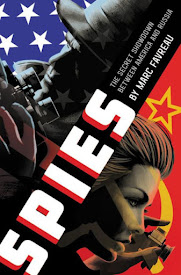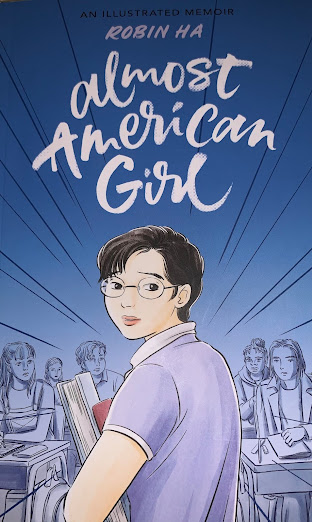Spies
Biography of the Author:
History is something that is often overlooked when it comes to young adult literature. 52-year-old Marc Favreau is an author who has made it a point to incorporate some of the most significant events in all the history of the United States into young adult literature. Marc Favreau was born in Martha’s Vineyard, Massachusetts, and was always interested in history as a child and young adult. Favreau’s immersion into the world of history began when his dad began to take him to different historical landmarks throughout the United States. It was then when he became fascinated with history and developed a desire to want to write about the stories that he heard. Despite his deep interest in history, Favreau did not start off as an author but rather as an editor for history book authors. He also wanted to teach history since he loved it so much and saw the value that knowledge of history provided. Although Favreau works with adults who are writing novels for an adult audience, he wanted to shift to writing his own novels for young adults as he has two teenage sons himself. Favreau wanted young adults like his children to be able to develop a greater understanding of the events that were happening and are currently happening in history, which would allow them to “be conscious of the world around them,” he told The Vineyard Gazette. Favreau wanted young adults to have more nonfiction options available to them, which lead him to blend his passion for history and desire for more historical novels in young adult literature together. He wants young adults to have a very honest and true understanding of the realities of history, such as racism, anti-Semitism, and violence. Favreau has written two books, all pertaining to historical events that target a young adult audience. So far, he has written about the Great Depression and the post-World War II entering the Cold War era. Who knows what important event Favreau will write about next? Any ideas?
Review:
Marc Favreau’s Spies: The Secret Showdown Between America and Russia, is an informative historical account for young readers, of the real-life events that constitute the Cold War. This novel chronicles from 1940-1994, the key figures and news-breaking events that acted as turning points for both countries. Favreau breaks down the timeline of the Cold War and paints a clear picture of the anxiety that stretched across the nation after the Hiroshima bombing; the nuclear arms race between Russia and the U.S. had begun and growing tensions only escalated as the USSR began to build power and stretch its communist ideals nationwide. With every turn of the page, the race for America to win such a treacherous war is felt; with details of important historical dates that span from just before the destruction of the Korean war all the way to Ronald Reagan’s ban on Soviet commercial flights. Though many of these events are well known, Spies’ hook that keeps the reader’s interest is its focus on the C.I.A and K.G.B operatives that were in the middle of it all. Through a collection of pictures, conversations, direct quotes, and name-dropping, Favreau bullet points a list of spies from both sides that turned the tides of the Cold War numerous times. He provides information on those like Elizabeth Bentley, a Soviet spy who defected to the U.S. and exposed one of the biggest spy rings in F.B.I history, and other spies like Aldrich Aims, a C.I.A operative who defected to the Soviet side and betrayed over one hundred C.I.A operations. What makes this novel work is Favreau’s narrative voice. Rather than laying out date upon date, he makes dense historical moments easy to understand, easy to follow, and entertaining to hear. The lens of the novel is looked at from the many playmakers of that time; flipping from the perspective of spies in Moscow, London, and Berlin, the heads of C.I.A agencies, and the outward worries displayed by both Russian and U.S. officials. The build-up to each event is fascinating and as it goes along, the way they tie together start to unravel, leading to an explosion of forty years worth of uncovered intel. What makes this novel even better are the helpful additions that come with it. For the average reader who might not be a history buff, Favreau includes a glossary for cold war terms and espionage techniques. Also included are key facts about the C.I.A and K.G.B organizations, a cold war timeline of the mentioned events, and an update on C.I.A and Russian espionage tactics since the end of the cold war. Not to mention the insightful section that lists Favreau’s primary sources and a list of additional sources that could be used for further reading. Spies is one energetic tale, and for anyone who picks up this story shrouded in government scandals, it's one you just can’t put down!
Instructional Resources:
- Get to Know SPIES, by Marc Favreau :This brief minute video comes from the author himself, Marc Favreau. If students were to watch this, ideally it would be before reading the book. Favreau gives an overview of what teachers and students alike can expect from the book; pivotal historical events, espionage, and the heroic figures that took part in this silent war.
- Language of Espionage : One of the greatest features of Spies and of the genre of spy novels, films, and video games in general is the secret terminology they utilize while on the field. The website of the Spy Museum located in Washington D.C. catalogues a large amount of the terms used during operations of espionage, used by both the United States and the Soviet Union. A personal favorite is ‘Throwaway’ which is defined as ‘An agent considered expendable’.
- The Cold War: Crash Course US History #37: The intention for this source is that students may get a firmer understanding of the context of the Cold War in an exciting and exuberant way. After exploring other brief video documentaries on the Cold War, with the intended audience being High School students, this one is by far of the best quality. John Green of Crash Course covers the history of the cold war in a 13 minute video full of animations, jokes, and witticism that students will love.
- The Cold War Timeline: This source is also for the purpose of context. However, this is meant for those who prefer to read, rather than those who prefer watching videos. Beginning from the Yalta conference of 1945 and ending with the Fall of the Soviet Union in 1991, this timeline covers every major event that occurred during the Cold War.
- 38 Most Amazing Spy Gadgets From The Cold War Era: Another exciting feature about studying the Cold War is the development of spy technology. This short article by the science website Techno Crazed provides pictures and brief descriptions for 38 devices used during the Cold War. One device that stands above the rest is the single-use encoder pad which was mentioned in the novel.
- Why Julius And Ethel Rosenberg Were Executed For Espionage At The Height Of The Red Scare: Spies does a fair job at summarizing the deeds and duties of the American and Russian spies and the consequences that follow. However, there are certain players in the Cold War in which students will want to research further, such as the Rosenburgs. Thus, this article provides the full story of Julius and Ethel Rosenburg before the war, their alleged involvement with the Soviets, and the trial that resulted in their executions, featuring testimonies by their friends, David and Ruth Greenglass.
- McCarthyism: One of the more prominent themes in Spies is the prevalence of McCarthyism. Occurring amid the Red Scare, McCarthyism was the period when hundreds of Americans were accused, without substantial evidence, of conspiring or supporting communism. Much like the previous source, this article summarizes the period that was coined by the belligerent accusations of a Wisconsin State Senator.
- World on the Brink: John F. Kennedy and the Cuban Missile Crisis:One of the most major, and the most terrifying events of the Cold War was the Cuban Missile Crisis. This virtual exhibit from the John F. Kennedy Presidential Library and Museum grants students a deep look inside the White House during these harrowing thirteen days. This virtual exhibit includes, photos, dates, documents, and audio excerpts from the meetings that took place with President Kennedy.
Instructional Activity: Spy Suspect Map (8th Grade ELA)
Goals:
Students will become detectives as they put together suspect maps for the most prominent spies in Russia and America during the Cold War. The maps will be composed of suspect cards, a timeline of the Cold War, and a key terms worksheet.
Utilizing context clues and a dictionary, students will be able to define key terms used in Spies.
Using textual evidence from Spies, students will find information regarding the spies listed and add that information to the suspect cards provided.
This activity will strengthen the students' knowledge of the cold war while also allowing them to practice their ability to close-read and decipher information in nonfiction novels.
California Common Core Standards:
Students will become detectives as they put together suspect maps for the most prominent spies in Russia and America during the Cold War. The maps will be composed of suspect cards, a timeline of the Cold War, and a key terms worksheet.
Utilizing context clues and a dictionary, students will be able to define key terms used in Spies.
Using textual evidence from Spies, students will find information regarding the spies listed and add that information to the suspect cards provided.
This activity will strengthen the students' knowledge of the cold war while also allowing them to practice their ability to close-read and decipher information in nonfiction novels.
CCSS.ELA-LITERACY.RL.8.1: Cite the textual evidence that most strongly supports an analysis of what the text says explicitly as well as inferences drawn from the text.
CCSS.ELA-LITERACY.RI.8.3: Analyze how a text makes connections among and distinctions between individuals, ideas, or events.
CCSS.ELA-LITERACY.RI.8.10: By the end of the year, read and comprehend literary nonfiction at the high end of the grades 6–8 text complexity band independently and proficiently.
CCSS.ELA-LITERACY.RH.6-8.4: Determine the meaning of words and phrases as they are used in the text, including vocabulary specific to domains related to history/social studies.
CCSS.ELA-LITERACY.RH.6-8.8: Distinguish among fact, opinion, and reasoned judgment in a text.
Resources and Preparation:
Students should be finished reading Spies by Marc Favreau
Students should be split into small groups of 3 or 4 students
Each group should have their own copy of Spies, pens or pencils, a key terms worksheet, a “find the date” worksheet, a spy suspect card, access to a dictionary, and sticky notes*
*Sticky notes are optional but encouraged if students want to make notes in their books
Instructional Plan:
Day 1: Split the class into small groups of 3 or 4 kids each. They will stay in this group for the rest of the lesson. Begin the first day of the lesson with a whole-class discussion of the book as a whole; take this opportunity to ask the students what they thought of the book and if they were surprised by anything they read. This class discussion should be used to make them more comfortable talking to each other since this lesson will be all about teamwork. After about fifteen minutes of a whole-class discussion about the book, give each group a key terms worksheet. They will work together to find and define these key terms for the rest of the class period.
Day 2: Begin the class with a review of the key terms they defined last class. Have groups share out the definitions they found and compare definitions to other groups. If some key terms proved to be difficult, offer some help or give them the correct definitions. Next, pass out the "Find the Date" worksheet. Depending on how hard the key terms were for the students to define, the “Find the Date” worksheet can be adapted to a whole-group discussion, otherwise, it will be the same as the keywords worksheet. If the worksheet is adapted to a whole-group discussion, give each group a single date to find in the book and then simply fill in the whole worksheet together as a class.
Day 3 & 4: Begin the class by reviewing the “Find the Date” worksheet to ensure that each group has the correct answers and lead a discussion on how the groups found the correct dates in the text. After the discussion, give each group a suspect card. They will now have to use the terms, the dates, and the text to fill out the suspect cards. Keep in mind that different groups should have different suspect cards, so it will be much harder for the groups to intermingle during this part of the lesson. Depending on how the groups are progressing, allow at least one or two days to fill out the cards. Once each group has their cards filled out, invite everyone up to the whiteboard and complete the suspect map. Allow the groups to place their suspect cards on the board, along with their “Find the Date” worksheets. End the lesson with a closing discussion surrounding the specific spies and their connection to the dates on the “Find the Date” worksheets. Encourage the students to practice using key terms in their discussions as well.
Bibliography
Admin. “38 Most Amazing Spy Gadgets From The Cold War Era.” TechnoCrazed, 21 May 2015, www.technocrazed.com/39-most-amazing-spy-gadgets-from-the-cold-war-era.
BakerandTaylorTV, director. Get to Know SPIES, by Marc Favreau. YouTube, YouTube, 11 Sept. 2019, www.youtube.com/watch?v=NISetFlHGKk.
“Bringing the Great Depression to Life for Young Adult Readers.” The Vineyard Gazette - Martha's Vineyard News, vineyardgazette.com/news/2018/05/10/bringing-great-depression-life-young-adult-readers.
“The Cold War Timeline.” History, 25 Oct. 2019, www.historyonthenet.com/the-cold-war-timeline-2.
Crashcourse, director. The Cold War: Crash Course US History #37. YouTube, YouTube, 8 Nov. 2013, www.youtube.com/watch?v=9C72ISMF_D0.
John F. Kennedy Presidential Library & Museum. Cuban Missile Crisis - John F. Kennedy Presidential Library & Museum, microsites.jfklibrary.org/cmc/.
“Language of Espionage.” International Spy Museum, www.spymuseum.org/education-programs/spy-resources/language-of-espionage/#D.
“Marc Favreau.” Little, Brown Books for Young Readers, Little, Brown Books for Young Readers, 11 May 2021, www.lbyr.com/contributor/marc-favreau/.
Margaritoff, Marco. “The Controversial Story Of The Only Americans Executed For Espionage During The Cold War.” All That's Interesting, All That's Interesting, 13 Mar. 2020, allthatsinteresting.com/julius-and-ethel-rosenberg.
“McCarthyism.” The Cold War, 30 Sept. 2020, alphahistory.com/coldwar/mccarthyism/.
National Governors Association Center for Best Practices, Council of Chief State School Officers. “California Common Core State Standards- English Language Arts & Literacy”. National Governors Association Center for Best Practices, Council of Chief State School Officers, Washington D.C. 2010. Accessed 15 April 2021.








